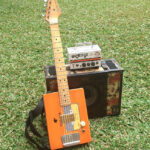For guitarists seeking freedom on stage and in the studio, wireless systems are a game-changer. However, the quest for the perfect wireless setup often brings up a critical concern: battery life and replacement. Many musicians, like the user from the Kemper Amps forum, are looking for a reliable wireless guitar system that doesn’t become obsolete due to a dead internal battery. The ideal solution? A system that offers the convenience of replaceable batteries, ensuring longevity and consistent performance for years to come.
The user initially favored systems like the Line 6 Relay G10 and Sennheiser XSW-D, appreciating the single transmitter and receiver-based charging port design. However, the lifespan limitation of internal batteries became a major drawback. The Relay G10, after just two years, faced battery failure, highlighting the challenge of difficult and potentially hazardous battery replacement in such units. This experience fueled the search for a wireless system that could stand the test of time, ideally powered by easily swappable disposable batteries or common rechargeable battery standards.
While the Sennheiser XSW-D was considered, its internal battery design raised similar longevity concerns. The market seems to lack readily available digital wireless systems utilizing AA or AAA rechargeable batteries. Older Samson wireless units, known for their AA battery compatibility, are becoming harder to find and may present frequency compatibility issues in some regions. This reveals a noticeable gap in the market for wireless guitar systems that prioritize user-replaceable batteries for extended lifespan and reduced electronic waste.
Alt text: A guitarist performing on stage with a wireless guitar system, highlighting the freedom and mobility it provides.
Despite the battery dilemma, the user opted for the Sennheiser XSW-D and shared valuable insights based on a year of use. Setting up the receiver permanently in a rack with continuous power eliminates charging anxieties. Utilizing two transmitters ensures one is always charged and ready, a practical workaround for internal battery systems.
Sennheiser XSW-D User Experience: Pros and Cons
Positives:
- Exceptional Range and Reliability: The Sennheiser system delivers impressive range with no signal dropouts, crucial for larger stages and dynamic performances.
- Simplicity of Operation: Ease of use is a significant advantage, allowing for quick setup and seamless integration into any guitar rig.
- Multiple Transmitter Capability: The ability to use multiple transmitters with a single receiver adds flexibility for quick guitar changes or backup options.
Negatives:
- Swivel Joint Durability: An early issue with a loose swivel joint on the transmitter highlights a potential weak point in the design, though this was resolved through a return.
- Single Button Operation: The single-button interface, while simple, can be somewhat cumbersome for navigating settings and options compared to systems with more dedicated controls.
In conclusion, the search for a “Good Wireless Guitar System” with truly replaceable batteries reveals a current limitation in the market. While systems like the Sennheiser XSW-D offer excellent performance and convenience, the reliance on internal batteries remains a concern for long-term reliability. Guitarists prioritizing longevity and battery swap options may need to explore older systems or hope for future innovations that bridge this gap in wireless technology.

